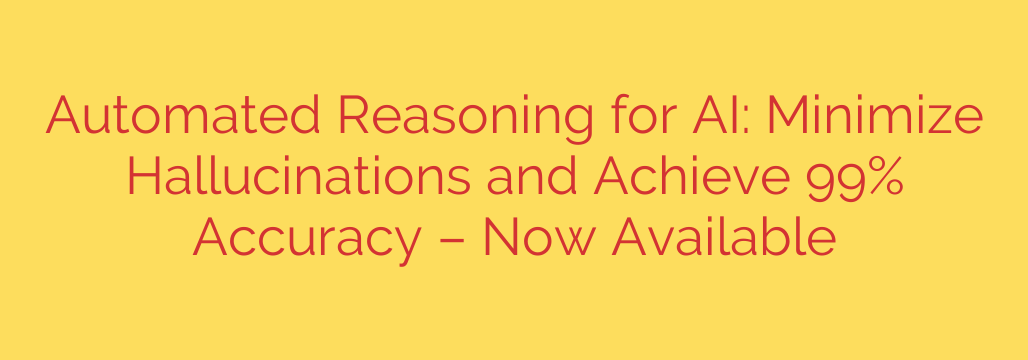
How Automated Reasoning Is Fixing AI Hallucinations and Boosting Accuracy
Generative AI and Large Language Models (LLMs) have taken the world by storm, offering incredible potential to revolutionize industries. Yet, for all their power, they harbor a critical flaw that hinders widespread adoption in high-stakes environments: the tendency to “hallucinate.”
An AI hallucination occurs when a model confidently presents false or nonsensical information as fact. This can range from citing non-existent legal cases to providing incorrect medical advice or generating flawed software code. For businesses, this isn’t just an inconvenience—it’s a major liability that undermines trust and creates significant risk.
The core challenge has been that LLMs are built on probability, not truth. They are designed to predict the next most likely word in a sequence, which doesn’t guarantee factual accuracy. A new approach, however, is emerging to solve this problem: Automated Reasoning.
The Billion-Dollar Problem: Why AI Hallucinations Undermine Trust
Before deploying AI for critical business functions, leaders must ask a simple question: “Can I trust the output?” Without a reliable way to verify AI-generated content, the answer is often a hesitant “no.” This trust gap is the single biggest barrier to leveraging AI in sectors where precision is non-negotiable.
Imagine the consequences:
- In Finance: An AI generating a financial report based on hallucinated market data could lead to disastrous investment decisions.
- In Healthcare: A diagnostic assistant suggesting a course of treatment based on a misinterpretation of patient data could endanger lives.
- In Software Development: An AI coding assistant introducing subtle but critical security vulnerabilities into an application could lead to massive data breaches.
To move from novelty to necessity, AI must become verifiably accurate.
A New Solution Emerges: What Is Automated Reasoning?
Unlike traditional machine learning, which relies on identifying patterns in data, automated reasoning is a field of computer science that uses formal logic to prove whether statements are true or false. Think of it as an AI fact-checker that operates with mathematical certainty.
While a standard LLM generates content based on probability, an automated reasoning engine validates that content against a set of established rules, facts, and logical constraints. It doesn’t guess—it proves.
This combination offers the best of both worlds: the creative, content-generating power of LLMs and the rigorous, truth-seeking discipline of logic-based verification. By implementing this two-step process, it is now possible to catch and correct hallucinations before they ever reach the end-user, pushing accuracy rates upwards of 99%.
From Theory to Practice: How Automated Reasoning Enhances AI
Integrating automated reasoning into an AI workflow creates a powerful system of checks and balances. The process typically works like this:
- Generation: An LLM receives a prompt and generates an initial response, complete with data, code, or analysis.
- Verification: The automated reasoning engine instantly analyzes this output. It checks the response against a verified knowledge base, internal company data, or a set of logical rules. For example, it can verify that a legal citation actually exists or that a line of code adheres to security protocols.
- Correction or Confirmation: If the engine finds a factual error or logical inconsistency, it can flag the content, correct it, or ask the LLM to regenerate a valid response. If the output is verified as correct, it is passed along with a high degree of confidence.
This Generation-Verification-Correction loop is the key to building AI systems that are not only powerful but also consistently reliable and safe for enterprise use.
How to Build More Trustworthy AI Systems
For any organization looking to deploy AI responsibly, focusing on accuracy and reliability is paramount. Here are actionable steps you can take to build more trustworthy systems:
- Implement a Verification Layer: Never blindly trust the raw output of a generative AI model for critical tasks. Employ a verification layer, whether through automated reasoning tools, rule-based checks, or a structured human-in-the-loop process.
- Ground Your AI in Factual Data: Connect your LLMs to curated, verified knowledge bases. By “grounding” the AI in your own trusted data, you drastically reduce its ability to invent information and ensure its responses are relevant to your business context.
- Demand Transparency from Vendors: When evaluating AI solutions, ask specific questions about how they address hallucinations and ensure factual accuracy. Inquire about their validation methods and the accuracy rates they can guarantee.
- Test Rigorously and Start Small: Before full-scale deployment, pilot AI in a controlled environment. Focus on a specific, high-value use case and rigorously test its output for accuracy and reliability.
The Future of AI Is Verifiable
The next wave of AI innovation will not be defined by the size of the models, but by their reliability. As businesses move from experimentation to implementation, the demand for verifiably accurate and trustworthy AI will only grow.
Automated reasoning represents a monumental step forward in this journey, transforming generative AI from a promising but flawed technology into a dependable tool that businesses can confidently deploy for their most critical operations. The future of AI is not just intelligent—it’s provably correct.
Source: https://aws.amazon.com/blogs/aws/minimize-ai-hallucinations-and-deliver-up-to-99-verification-accuracy-with-automated-reasoning-checks-now-available/








